Elizabeth Barlow talks about creating portraits in still life form, by capturing the essence of her subjects’ journeys via their personal effects, in an interview with Sonalee Tomar for the Asian Curator.
Ironically, the piece I was working on and completed amidst the early news of the pandemic is about rebirth and revitalisation, and it is called The Phoenix Rose. This six-foot painting was created for a prominent art collector who is currently rebuilding his California vineyard home after it was destroyed in a devastating wildfire. Only a few redwood trees, his grapevines and one extraordinary rose bush survived the fire. Like the mythological phoenix bird, this rose bush rose out of the ashes of that fire.
Featured image: The artist at her easel. Image credit: Ethan Pines.
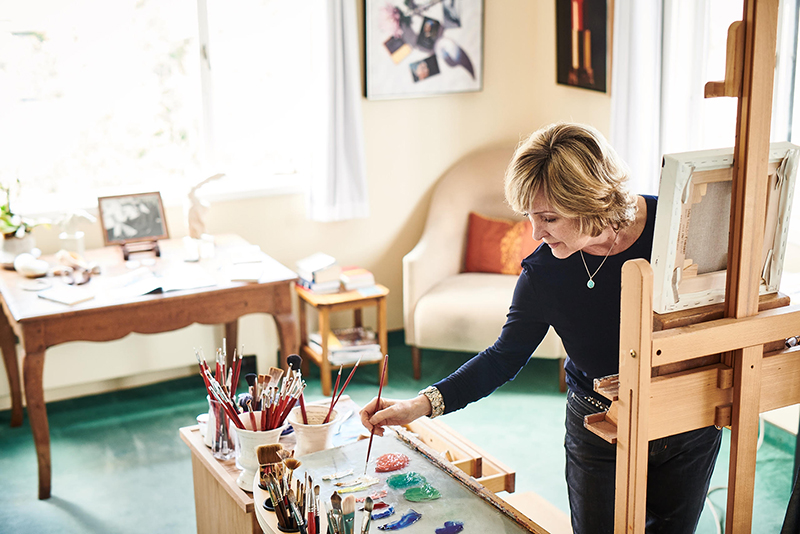
The artist at work. Image credit: Ethan Pines.
Tell us about the evolution of your practice over the years. What would you call your style?
As a contemporary still life artist, my work is infused with a life-long love of portraiture. Long ago, I decided I wanted to find a way to create portraits in still life form. So, rather than painting a face or body, I decided to use the symbolism of objects, whether organic or man-made to explore the poetry of our lives and world. By focussing on objects and our relationship to them, I am able to offer a fresh vantage point from which to consider identity, place, time and memory. A beloved personal object retains the essence of the person who chose it, and I believe that these items have the power to contain, as well as reveal the very shape of our lives. I call these portraits Portraits in Absentia. When I begin a “portrait in absentia”, I select objects that symbolise complex and perhaps contradictory aspects of my subject’s personality and life story. I arrange these objects in a composition and through the use of colour, light and shadow I am able to amplify these seemingly mundane items into a work of art that reveals truths about the personal journeys of their owner.
When I begin a “portrait in absentia”, I select objects that symbolise complex and perhaps contradictory aspects of my subject’s personality and life story. I arrange these objects in a composition and through the use of colour, light and shadow I am able to amplify these seemingly mundane items into a work of art that reveals truths about the personal journeys of their owner.

BE. Oil on linen. 10 x 10 in. Private Collection.
When my husband and I moved from San Francisco to the beautiful Monterey Peninsula in 2016, I was intoxicated by the sea air, the trees, and the bountiful flowers that suffuse our lives here. I wanted to find my own way to paint flowers — not arranged in vases or on tabletops – but in a way that felt true to my way of painting. So, I extended my idea of Portraits in Absentia to include flowers and began a new series entitled Flora Portraits. When I begin a project in this body of work, I visit a garden and collect armloads of blossoms, vines, leaves and branches. Later, in my studio, I create a composition that celebrates the essence of the garden or the gardener, and at the same time highlight the bittersweet impermanence of life.

Elizabeth’s late father, artist Philip Barlow.
What inspires you? Let’s talk about your frameworks, references and process.
My work is deeply inspired by the work of my late artist father, Philip Barlow, and by my heroes in painting, literature and music who continue to inform my work profoundly. The lessons they taught, and continue to teach me, can be found as echoes in each brushstroke of my paintings. Some of the artists who inspire me are Georgia O’Keeffe, Anne Truitt, Martha Alf, David Ligare, Claudio Bravo and Alison Watt.
In addition, whenever I need a jolt of energy or need to remind myself of the strength and courage it takes to be an artist, I find renewal in the daily practice and work of classically trained dancers and musicians. They show up at the barre or the instrument each and every day, no matter how they are feeling. The practice of any artist requires the same dedication. It is a kind of spiritual devotion to something greater than oneself that I admire – and it always inspires me when I need a boost.
In all of my work, Portraits in Absentia, Flora Portraits, and Still Life, each painting begins with reference photos I take myself and then edit on my computer. Next comes one of the most important parts of my process – deciding on an evocative composition. I then make a pencil drawing on a custom-made oil-primed linen canvas, followed by an alla prima layer of oil colour. This is followed by many glazed layers to develop the richness, depth, subtlety and luminosity that I seek. With each painting, I aim for more than an accurate representation of form – I strive to reveal the spirit and underlying meaning in an object that is always present – if we will only take the time to look.

Portrait of a Marriage. 12 x 12 in. Oil on Linen. Private Collection.
What were your biggest learning and hiccups along the way in your artistic journey?
Early in my life as an artist, I easily fell into despair when a painting didn’t go as I hoped it would. I could quickly go from elation at the beginning of a painting to feelings of abject failure when faced with a challenging area in a painting. I would find myself thinking, “I really don’t think I can pull this painting off.” Now, with years of experience and many painting challenges behind me, I have confidence that I can find my way through a difficult passage in a painting. And it is often in those challenging places that I discover a new way to handle paint, or mix colours, or adjust values. I may not enjoy it, but there are “crises” in every painting and I now know that it’s my job to embrace them and work through them.

The Phoenix Rose. 40 x 72 in. Oil on Linen. Private Collection.
What were you working on when the lockdown was announced?
Ironically, the piece I was working on and completed amidst the early news of the pandemic is about rebirth and revitalisation, and it is called The Phoenix Rose. This six-foot painting was created for a prominent art collector who is currently rebuilding his California vineyard home after it was destroyed in a devastating wildfire. Only a few redwood trees, his grapevines and one extraordinary rose bush survived the fire. The rose bush bloomed gloriously in the spring following the fire and has continued to thrive ever since. The painting is symbolic of so many things: his own hopeful spirit, the memories of his late wife, and the resilience of the natural world. Like the mythological phoenix bird, this rose bush rose out of the ashes of that fire, and so I named the painting The Phoenix Rose. As the painting is being prepared to be installed in the master bedroom of the new home, which is expected to be completed in August 2020, it is a beautiful visual reminder that we always have the opportunity to rebuild while surrounding ourselves with inspiration.
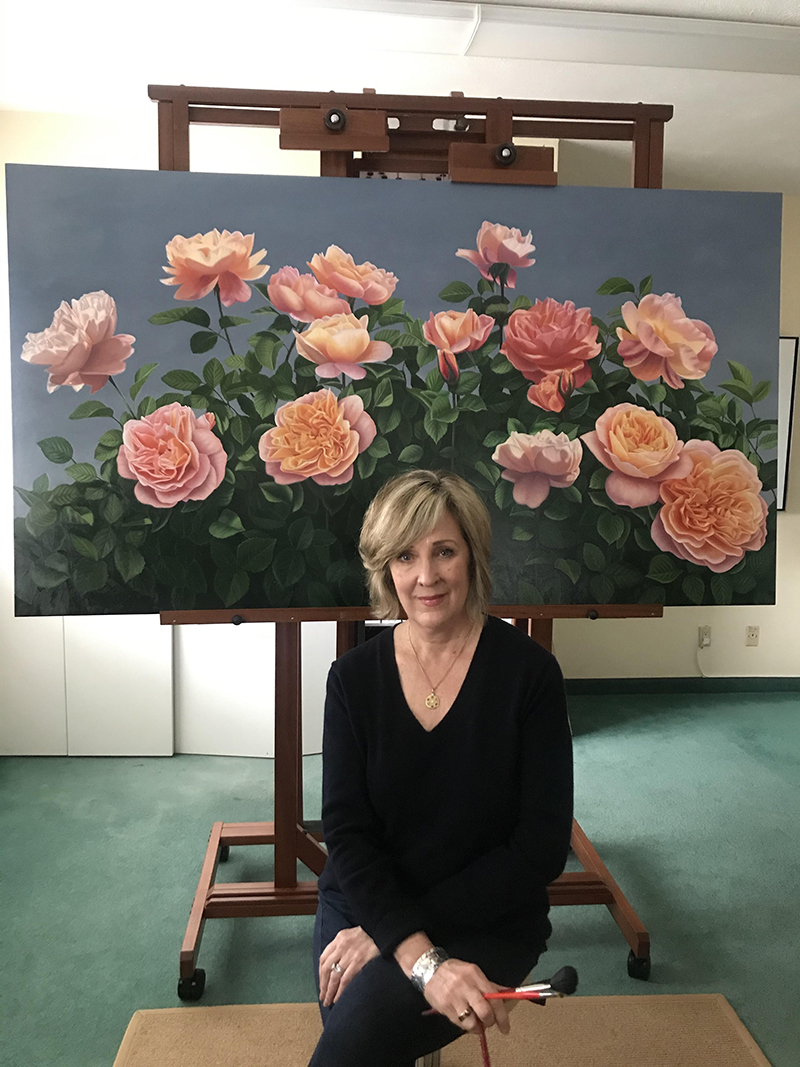
The artist in her studio with The Phoenix Rose painting.
How are you balancing life and work at home during this period? How has this affected your practice and plans?
I suspect that a lot of artists feel the same way I do in these extraordinary times. On the one hand, my heart aches for all the people whose lives are difficult and painful at this time. But as an artist, my working days in the studio are the very definition of self-isolation, so not much has changed in my working life – except for the better.
In “normal” times, I constantly struggle to balance my dedicated hours of studio practice, my home life with my husband, our extended families and social lives, and the various temptations and obligations of a busy life. But during the lockdown, all that has disappeared. My days are now spent at my studio, or taking long walks with our poodle, or at home with my husband spending cozy evenings. There is more time for reading, musing, dreaming and planning. I feel as if I am on an extended artist residency, except that I still need to cook and do laundry.
Seriously, I feel this is a very precious time and an opportunity to hit the “pause” button and evaluate how I spend my time. One thing I have become very aware of is how the news affects my well-being and art-making. I limit myself to checking the news just twice a day. I want to be informed, but I don’t want to spend my mental and spiritual energies on the latest “breaking news.” I want to preserve my focus and energy for the things that truly matter to me. And the same goes for social media – I strictly limit my time there. And, guess what, there is so much more time for reading books and dreaming and observing!

What Beauty Is For. 36 x 30 in (diptych). Oil on Linen. Image courtesy: Andra Norris Gallery.
If I can use one word to sum up what I strive for in my studio life, it is serenity. My studio is in a beautiful church in the centre of Carmel-by-the-Sea, California, and is surrounded by an extensive contemplative garden.

The garden outside Elizabeth’s studio.
Tell us about your studio. Could you describe your usual work-day in the studio?
If I can use one word to sum up what I strive for in my studio life, it is serenity. My studio is in a beautiful church in the centre of Carmel-by-the-Sea, California, and is surrounded by an extensive contemplative garden. Each morning, I walk the mile to the studio and before the noise of the day intrudes too much, I spend a little quiet time looking at and thinking about my creative work for the day. I set myself clear time limits in other areas, particularly how long I will be spending on emails and social media.
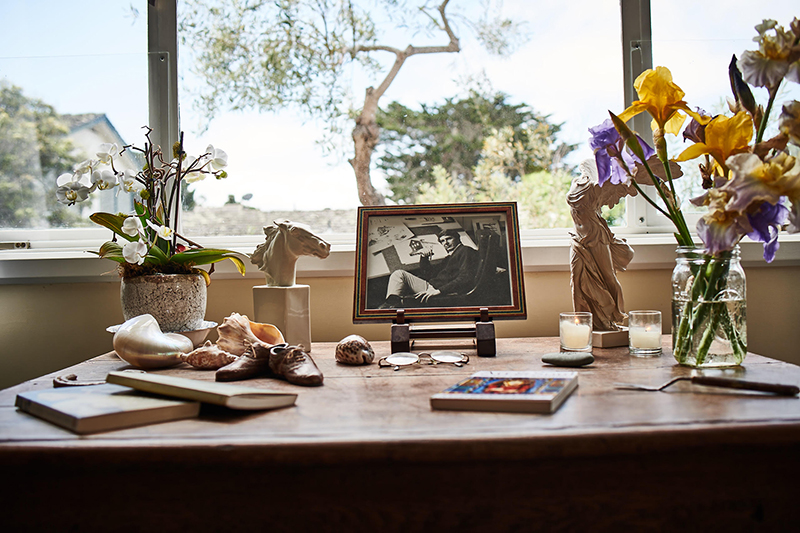
Studio table with mementoes and inspirations. Image credit: Ethan Pines.
Upon arrival at the studio, I first put music on. It is usually Bach or Mozart. Bach has deceptively simple rhythms that are truly complex. It is calming and helps my mind focus deeply. Often, I light a candle as a signal that my creative work is about to begin. I prepare hot water and make an organic green tea in a huge but beautiful mug. While it is steeps, I unpack my bag and make sure that everything is ready to go. Then, I sit and look at the work from the day before and see what is calling out for me to begin working on. I don’t go to email or social media obligations until I can look at the creative work to be done for the day and set my intentions for what I want to achieve with the painting that day. Next, I go to my palette, lay out fresh paint and mix the colours that I will use that day. I find that if I devote this time exclusively to my “real” work, then I can turn to my digital obligations without getting sucked into them for too long, because I have already spent time with my painting and palette and my mind is “tuned” into that frequency.
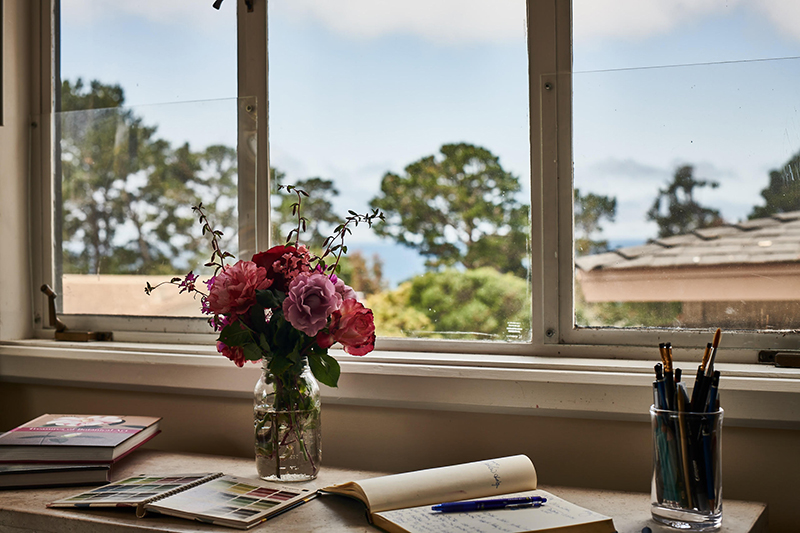
Sketching table in Elizabeth’s studio. Image credit: Ethan Pines.
When I begin painting, I switch to listening to an audiobook. I know a lot of other artists who do this too. I often listen to the same book over and over while working on a single painting (my painting process is a slow one!). The Phoenix Rose painting took me many months to complete, and I listened to all of Jane Austen’s novels while painting it. They were my beloved companions during those many long days at the easel.
Another important part of my studio practice is my studio journal. In this I keep a record of each painting as I am at work on it. I write what I hope to attain with the painting (and what works and what doesn’t work) and I also record the paint mixtures I use for each area of the painting. This helps when I go back and glaze into an area, and it also helps me recall the many twists and turns each painting takes until it emerges as its final self. For some paintings, I will repaint the background many times, and it helps to be able to refer to what colour mixtures I tried.
Finally, when it is time to leave the studio for the day, I always carefully clean my brushes and palette and put things back into order. I don’t want to walk in the next morning and see the detritus or struggles of the previous day’s work. I want to walk into a clean and bright studio each morning and start that day’s work with a feeling of hope and fresh possibility.
When the selection process is complete, I create a composition that tells a story or illuminates a cherished moment or special memory. The result is a personalised portrait: a painting that symbolises an aspect of the subject’s life and their fascinating life journey in a distinctly new way.

Portrait of Julia Child; a portrait in absentia by Elizabeth Barlow. 12 x 12 in. Oil on Linen. Private Collection.
Are you more of a studio artist or naturally collaborative by nature? How do you feel about commissions?
Commissioned paintings are an important part of my work, and I love the collaboration it brings. I work with the collector to curate a personal portrait often using symbolic objects and cherished belongings. We can choose anything that has a special meaning – a pair of boots or stilettos, a few dog-eared books, a worn pair of jeans, a hat, a gardening trowel, a wedding ring, a golf ball… When the selection process is complete, I create a composition that tells a story or illuminates a cherished moment or special memory. The result is a personalised portrait: a painting that symbolises an aspect of the subject’s life and their fascinating life journey in a distinctly new way.
For enquiries contact: elizabethbarlow@comcast.net
Before you go – you might like to browse our Artist Interviews. Interviews of artists and outliers on how to be an artist. Contemporary artists on the source of their creative inspiration.








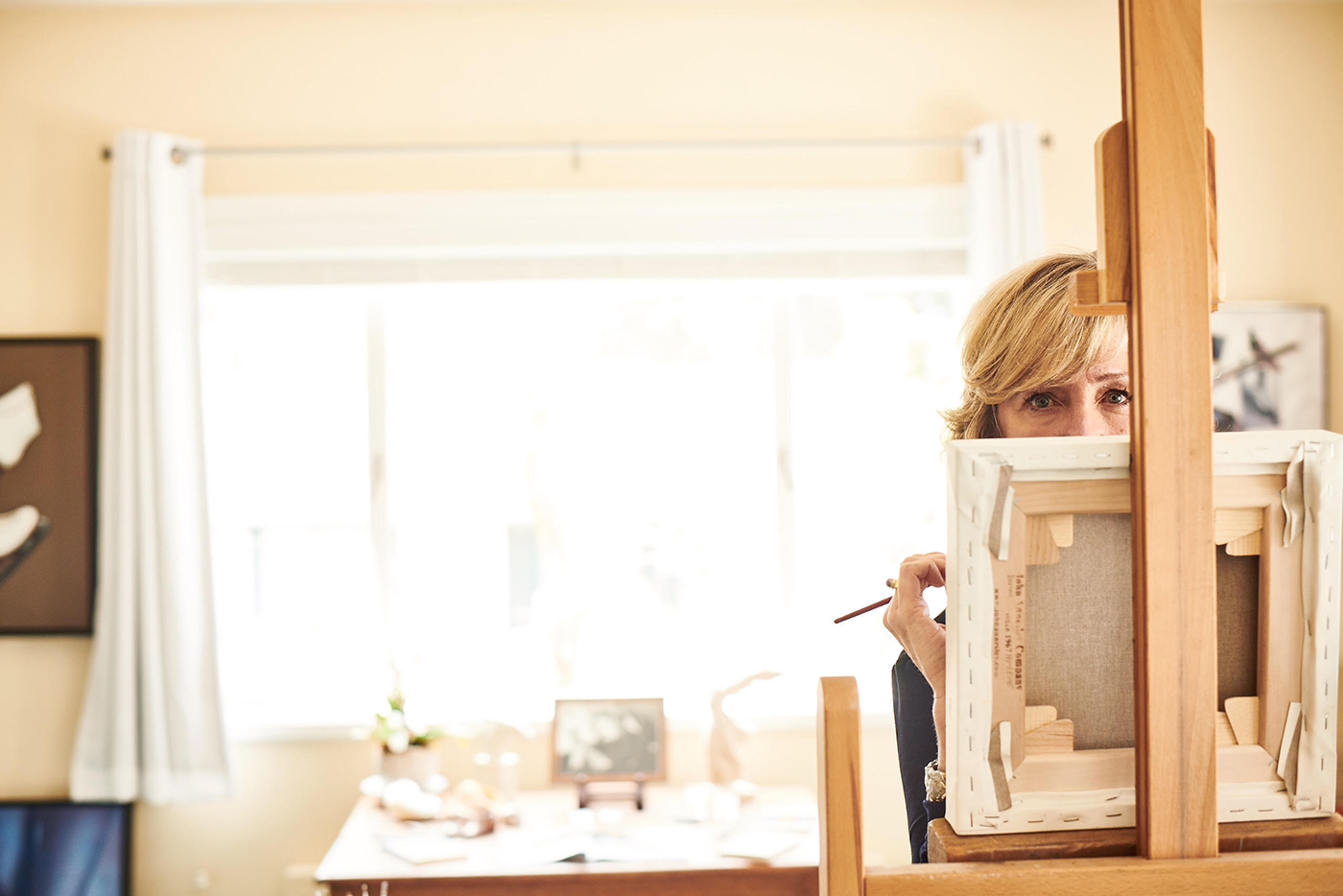



Add Comment